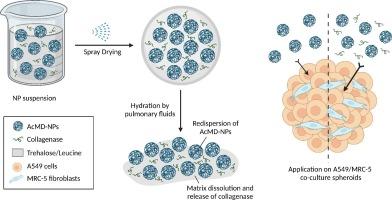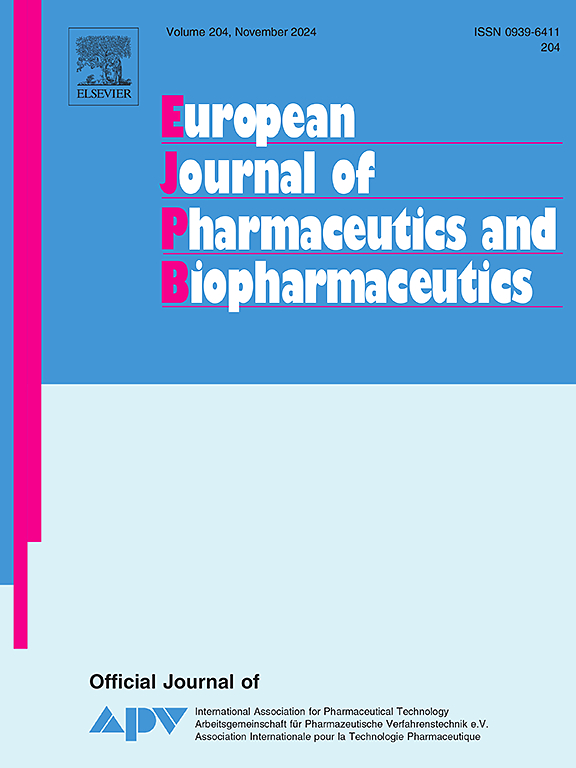用于调节细胞外基质的可吸入纳米结构微颗粒是一种潜在的肺癌给药系统。
IF 4.4
2区 医学
Q1 PHARMACOLOGY & PHARMACY
European Journal of Pharmaceutics and Biopharmaceutics
Pub Date : 2024-09-26
DOI:10.1016/j.ejpb.2024.114512
引用次数: 0
摘要
在肺癌治疗中使用可吸入纳米微粒系统可以有效地将药物输送到肺部局部,减少不良的全身接触。要做到这一点,吸入的微粒应具有最佳的沉积特性,同时避免肺部清除机制。此外,由于致密细胞外基质(ECM)的形成阻碍了治疗药物的渗透和扩散,因此向实体瘤给药具有更大的挑战性。为此,当前工作的目标是开发一种可调节 ECM 的纳米结构微粒载体,它不仅能将治疗用纳米粒子(NPs)输送到肺部,还能增强其瘤内渗透。该系统由嵌入水溶性三卤糖/亮氨酸基质的乙缩醛麦芽糊精(AcMD)NPs组成,其中装载了不同质量浓度(10%、30% 和 50%)的胶原酶。含胶原酶的 AcMD 纳米结构微粒(MPs)具有合适的中值体积直径(2.58 ± 1.35 至 3.01 ± 0.68 µm)、中空波纹状形态、足够的再分散性、较低的残余水分含量(2.71 ± 0.17 % 至 3.10 ± 0.20 %)和良好的空气动力学特性(质量中值空气动力学直径 (MMAD):1.93 ± 0.06 至 2.80 ± 0.10 µm 和细颗粒分数 (FPF):68.02 ± 6.86 % 至 69.62 ± 2.01 %)。重要的是,胶原酶在喷雾干燥后的酶活性保持率高达 89.5 ± 6.7%。含有 10% 质量分数胶原蛋白酶的 MPs 对人类肺腺癌 A549 细胞或肺 MRC-5 成纤维细胞均无细胞毒性迹象。使用腺癌 A549/MRC-5 共培养球形模型测试了纳米粒子的渗透性,结果表明,加入胶原酶后,AcMD-NPs 的渗透深度更深。本文章由计算机程序翻译,如有差异,请以英文原文为准。

Inhalable nano-structured microparticles for extracellular matrix modulation as a potential delivery system for lung cancer
The use of inhalable nanoparticulate-based systems in the treatment of lung cancer allows for efficient localized delivery to the lungs with less undesirable systemic exposure. For this to be attained, the inhaled particles should have optimum properties for deposition and at the same time avoid pulmonary clearance mechanisms. Drug delivery to solid tumors is furthermore challenging, due to dense extracellular matrix (ECM) formation, which hinders the penetration and diffusion of therapeutic agents. To this end, the aim of the current work is to develop an ECM-modulating nano-structured microparticulate carrier, that not only enables the delivery of therapeutic nanoparticles (NPs) to the lungs, but also enhances their intratumoral penetration. The system is composed of acetalated maltodextrin (AcMD) NPs embedded into a water-soluble trehalose/leucine matrix, in which collagenase was loaded with different mass concentrations (10 %, 30 % and 50 %). The collagenase-containing AcMD nano-structured microparticles (MPs) exhibited suitable median volume diameters (2.58 ± 1.35 to 3.01 ± 0.68 µm), hollow corrugated morphology, sufficient redispersibility, low residual moisture content (2.71 ± 0.17 % to 3.10 ± 0.20 %), and favorable aerodynamic properties (Mass median aerodynamic diameter (MMAD): 1.93 ± 0.06 to 2.80 ± 0.10 µm and fine particle fraction (FPF): 68.02 ± 6.86 % to 69.62 ± 2.01 %). Importantly, collagenase retained as high as 89.5 ± 6.7 % of its enzymatic activity after spray drying. MPs containing 10 % mass content of collagenase did not show signs of cytotoxicity on either human lung adenocarcinoma A549 cells or lung MRC-5 fibroblasts. The nanoparticle penetration was tested using adenocarcinoma A549/MRC-5 co-culture spheroid model, where the inclusion of collagenase resulted in deeper penetration depth of AcMD-NPs.
求助全文
通过发布文献求助,成功后即可免费获取论文全文。
去求助
来源期刊
CiteScore
8.80
自引率
4.10%
发文量
211
审稿时长
36 days
期刊介绍:
The European Journal of Pharmaceutics and Biopharmaceutics provides a medium for the publication of novel, innovative and hypothesis-driven research from the areas of Pharmaceutics and Biopharmaceutics.
Topics covered include for example:
Design and development of drug delivery systems for pharmaceuticals and biopharmaceuticals (small molecules, proteins, nucleic acids)
Aspects of manufacturing process design
Biomedical aspects of drug product design
Strategies and formulations for controlled drug transport across biological barriers
Physicochemical aspects of drug product development
Novel excipients for drug product design
Drug delivery and controlled release systems for systemic and local applications
Nanomaterials for therapeutic and diagnostic purposes
Advanced therapy medicinal products
Medical devices supporting a distinct pharmacological effect.

 求助内容:
求助内容: 应助结果提醒方式:
应助结果提醒方式:


